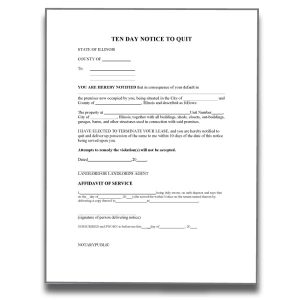Indiana Eviction Process
The following information is intended for residential landlords in Indiana and does not encompass commercial or agricultural property.
1. Prepare a notice to quit. Before a formal court filing can occur, a landlord needs to prepare the proper notice to terminate the tenancy:
- Indiana 10 Day Notice to Pay or Quit (For nonpayment of rent)
- Indiana Notice to Cure or Quit (For lease violations other than nonpayment)
- Indiana 30 Day Notice to Quit (For month-to-month agreements)
2. Serve the tenant and wait. A landlord must deliver the notice to the tenant and inform them of the violations. A landlord will then have the right to file for eviction after the notice period expires unless they offered the tenant a chance to correct the problem.
3. Summons and complaint is filed. If the tenant doesn’t comply with the demands as set forth in the notice, the landlord may begin eviction proceedings by filing a summons & complaint with a local court including the notice to quit.
4. Tenant is served summons & complaint. The landlord must have copies of the court documents served on the tenant, but this time a landlord must hire a process server to deliver the documents.
5. Eviction Order. The tenant is granted a few days to respond to the lawsuit by filing an answer. But if the tenant doesn’t respond, the landlord may request the court to issue a judgment for possession.
6. Sheriff’s Assistance. If the tenant is still living on the premises by the time the court rules in the landlord’s favor, the landlord has the right to ask the sheriff to escort the tenant off the property.
Notice to Quit
A 10 Day Notice to Pay or Quit demands a tenant to bring the rent current or vacate.
-
Original price was: $12.95.$9.95Current price is: $9.95.
A Notice to Cure or Quit is to demand a tenant to resolve their noncompliance with their lease agreement. Otherwise, the landlord may terminate the relationship.
-
Original price was: $12.95.$9.95Current price is: $9.95.
A 30 Day Notice to Quit is not initially for a violation, but for deciding not to renew a monthly rental agreement. It only becomes a part of the eviction process when a tenant refuses to move.


